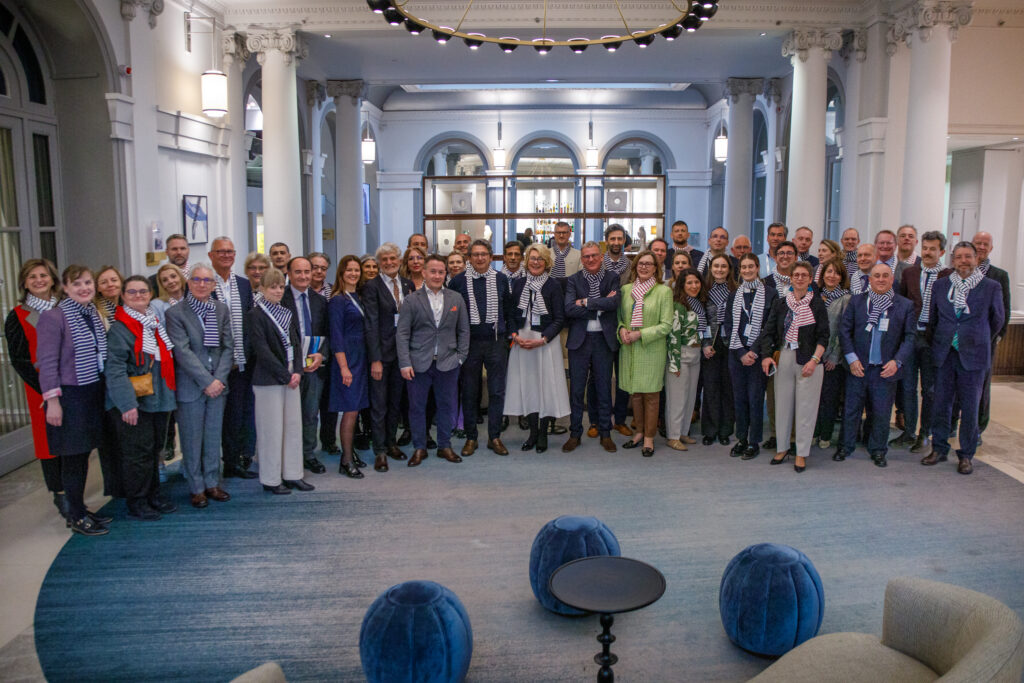╔
I am very grateful for having the opportunity to write and reflect about women in port cities, since both the port-city relation and boosting women’s employment in ports are issues close to my heart and topics that ESPO has had on its radar since many years.
How many ports in Europe are led by a woman? I cannot provide you with exact figures, but based on my knowledge, they can be counted on one hand.
But let us look at the broader picture. In 2017, the Commission revealed that only 22% of people working in the transport sector in Europe were women. Based on this, the European Commission launched in November 2017 the platform Women in Transport – EU Platform for change, with the objective to strengthen women’s employment and equal opportunities for women and men in the transport sector. The platform would bring about concrete actions of the platform members, and also serve as a forum to discuss and exchange good practices. ESPO became one of the founding members of the platform together with other EU organizations and a few Member States. Consulting the latest list of platform members, there are only four Member States part of the platform: Austria, Croatia, Spain and Sweden.
But how has the situation evolved since a concrete figure was put on the serious gender imbalance in the European transport sector? Based on the latest published Eurostat Statistics [1], the situation has not improved, on the contrary. The share of female workforce in transport in the EU went down to 17.1 % (2021). Looking at the different modes, waterborne is doing better with 21.9% of workers being female, compared to land transport with only 15,2% being women. Air transport leads with a 42% of the employment being female. Zooming in at the country level, Malta (25.2%), Cyprus (24.6%) and Germany (24.4%) seem to have the biggest share of female employment. The lowest shares were recorded in Romania (9.7%), Croatia (11.5%) and Bulgaria (12.1%). And what about cities? How many cities in Europe are being governed by women? According to 2019 data published by the European Institute for Gender Equality (EIGE), women mayors or other leaders and members of local and municipal councils in the EU-28 (UK was still included in these figures) accounted for 32.6 %. So it seems that women are more easily part of the political leadership of a city – and thus also of a port city, I assume – than they are manager or part of the leading team in the port.
Now zooming in on ESPO: what did we ourselves undertake as part of the Platform for Change? Conscious of the need to step up the presence of women in European ports, in 2018, the Chairman of ESPO at the time and CEO of the Port of Dublin, Eamonn O’Reilly, proposed to register the number of women participating in ESPO’s own meetings: its technical committees as well as its board and general assembly meetings. We started with this exercise in 2018 and ever since, we have been reporting every year about the results on the occasion of International Women’s Day. The first report in 2019 revealed that 31.76% of port professionals attending ESPO meetings were women. The last report, published on 8 March of this year shows that over 4 out of 10 port professionals (41%) participating in ESPO meetings in 2023 were women. So not only were our figures in 2019 already above average, but we also see a clear positive trend. These results capture all technical committees taken together. It is however worth the while to look at the different specialized committees. Knowing that technical committees are bringing together port professionals in a specific field, the results of our monitoring show that the highest scores, with even more women than men, are in ESPO’s Sustainable Development Committee, bringing together environmental managers of the port, as well as the Cruise and Ferry Port Network, gathering mainly the cruise managers of the ports. The least well performing in terms of women’s participation is the committee which is discussing trade facilitation and port safety issues. This committee traditionally gathers quite some harbor masters, which could explain the lower female presence as these tend to be male-dominated positions. Looking at the Executive Committee as the political body of the organization, we see that over the years on average one out of three board members present in our meetings is a woman [2]. Last but not least, the ESPO secretariat in Brussels is currently setting the example with 7 out of 9 working at the European Port House being women.

ESPO General Assembly – Paris 2024. (© Union des Ports de France, ESPO GA picture).
This brings us to the European political level: how important are women in developing transport policy? And there, I must say, the present picture is surprisingly positive: the European Commissioner for Transport, the Director General for Transport the acting Director Waterborne Transport and the Head of the Port Unit in DG MOVE, all are women. And to end this series, the European Maritime Safety Agency is also led by a woman.
Considering all these facts and figures, we can conclude that maritime and ports are doing better than land transport (rail, inland waterways and road) and that women are better represented in all politically related port functions, including at the level of ESPO.
Now, how can we increase the share of women working in ports in Europe? But first, more importantly, why should we aim at having a better gender balance in European ports?
I see at least four reasons:
- First, ports are multitaskers. Ports are much more than places where ships are being loaded and unloaded. They are gateways to trade and multimodal nodes, connecting maritime with the hinterland. Ports are housing important industries and production units, nodes of energy and facilitators of renewable energies, hubs of innovation and digitalization, key in enhancing the cohesion between the mainland and the more remote areas and islands, linking peripheral regions and islands to the mainland, transporting passengers and travelers, essential parts of emergency supply chains and facilitators of military preparedness, and clusters of blue growth and circular economy. This wider highly multifaceted role of ports implies a more diversified workforce, with new profiles and strengths. Ports do not only need strong tough men. Ports nowadays can count on strong tough machines, which need to be manned by skilled and smart people. Ports have to communicate about their new roles and explain what is behind the sometimes “unsexy packaging” of a port. Communication and dialogue with stakeholders are thus equally important as moving boxes. Working on the port’s sustainability ambitions, developing new businesses – in particular in the field of renewable energies or circular economy – is attracting new talents to the port and is generating jobs that can appeal to both women and men. In other words, the jobs in the port are not so different than the jobs on the labor market outside the port.
- Second, like men, women are also travelers, commuters, consumers, importers, exporters, cargo owners and thus also users of the port. Like men, women are citizens and know what it means to live in a port city. It is in the interest of both the port and its users to meet people working in the port that understand the needs of its users. In view of maintaining and further enhancing port-city relations, it is important that the port mirrors in a certain way its surrounding community. And how to better do this than by welcoming in the port the same diversity that is present in the urban agglomerations surrounding ports.
- Third, ports are linking people, economies and regions. Ports are mission-driven, combining general interest with commercial ambitions. Ports are matchmakers, facilitators, aimed at bringing not only economic added value, but also societal added value. Women can play an important role in combining these different ambitions and in capturing the needs of the nowadays port platforms, bringing new dynamics.
- Finally, considering the increasing staff shortages, it is important for ports to be able to benefit from a broader talent pool, which of course cannot be limited to men only.
While the added value of and need for women in the port is crystal clear, the reality on the ground looks still quite different and must be improved. While not an easy task, how to boost female employment in the port and make people understand that ports need women to be successful?
If one was to ask me, I would say explaining the new and multifaceted role of ports is essential. Open-up the port as much as you can to the city. Bring the citizens to the port. Engage them in the life of the port and make them proud of having a port in the city.
Working bottom up by showing good practices and positive experiences from women actually working in the port at different levels and in very diverse functions is also very important. The interviews which have been organized by Ms. Barbara Bonciani, City Councilor of Livorno, in the framework of the Women in Port project, initiated by the city of Livorno together with amongst others the University of Pisa and RETE, are a very good example. The concrete stories of the interviewed women are the best way to look beyond the stereotype images of the port worker and take away the barriers to enter the port labor market.
Adapting the traditional male working environment of the port into a workplace which is suitable for both men and women is another important point. The provision of women toilets with changing rooms is an example of a small but essential measure. Yet, beyond adapting the services to the needs of a gender-balanced workforce, it is equally important to work on the mentality of the workforce in the port. Both the working language, the communication and exchanges on the work floor must become more inclusive. It must be explained that ports are, like any other working place, a safe working environment for both men and women.
What I moreover considered as an important takeaway of the Women in Port project from the city of Livorno is the proposal to share experiences between ports and to try to obtain some more disaggregated data on the share of women in different functions in the ports. I think this could really help in improving the gender balance in ports, and I see a role for ESPO in facilitating this exchange.
Painting awarded for the ESPO award 2023 out of the series “The Colors of ESPO” by Sasja Hagens.

Let me conclude by referring to the ESPO Award that we give every year to a port who is engaging in an innovative way to maintain and enhance the port-city relations. The Award prize itself is a painting from the Dutch female port painter, Sasja Hagens, who has developed for ESPO two series of paintings “the colors of ESPO”, showing her – very positive – port vision. This, for me, is again another way of bringing women closer to ports and adding color to our ports.
HEAD IMAGE | Port of Livorno. (© Port System Authority of the Northern Tyrrhenian Sea).
╝
NOTES
[1] Key figures on European transport – 2022 edition.
[2] https://www.espo.be/news/in-2023-41-of-port-professionals-participating-in-/.